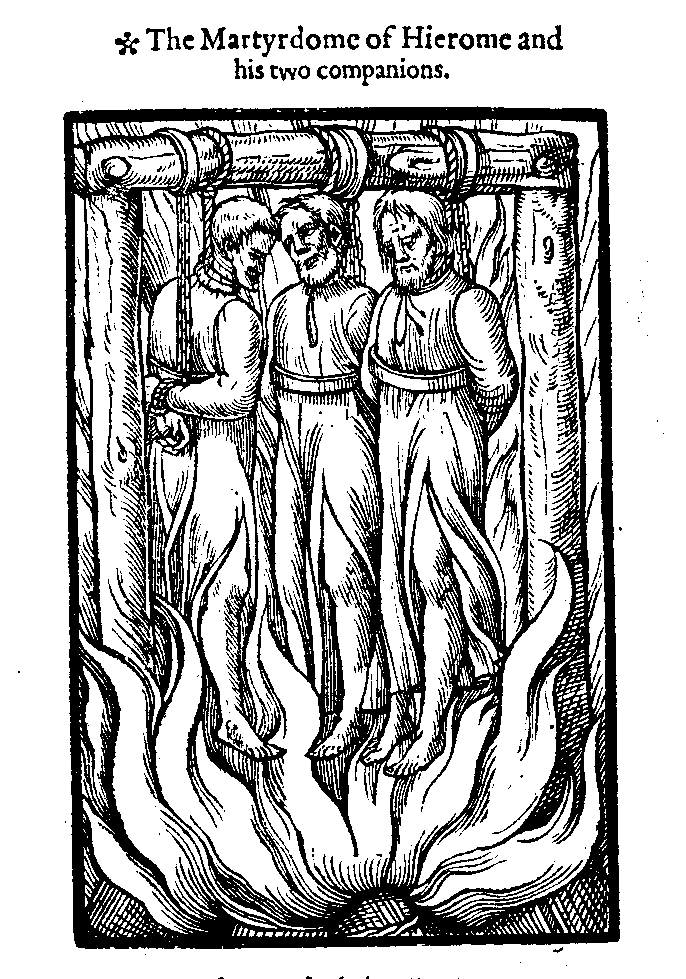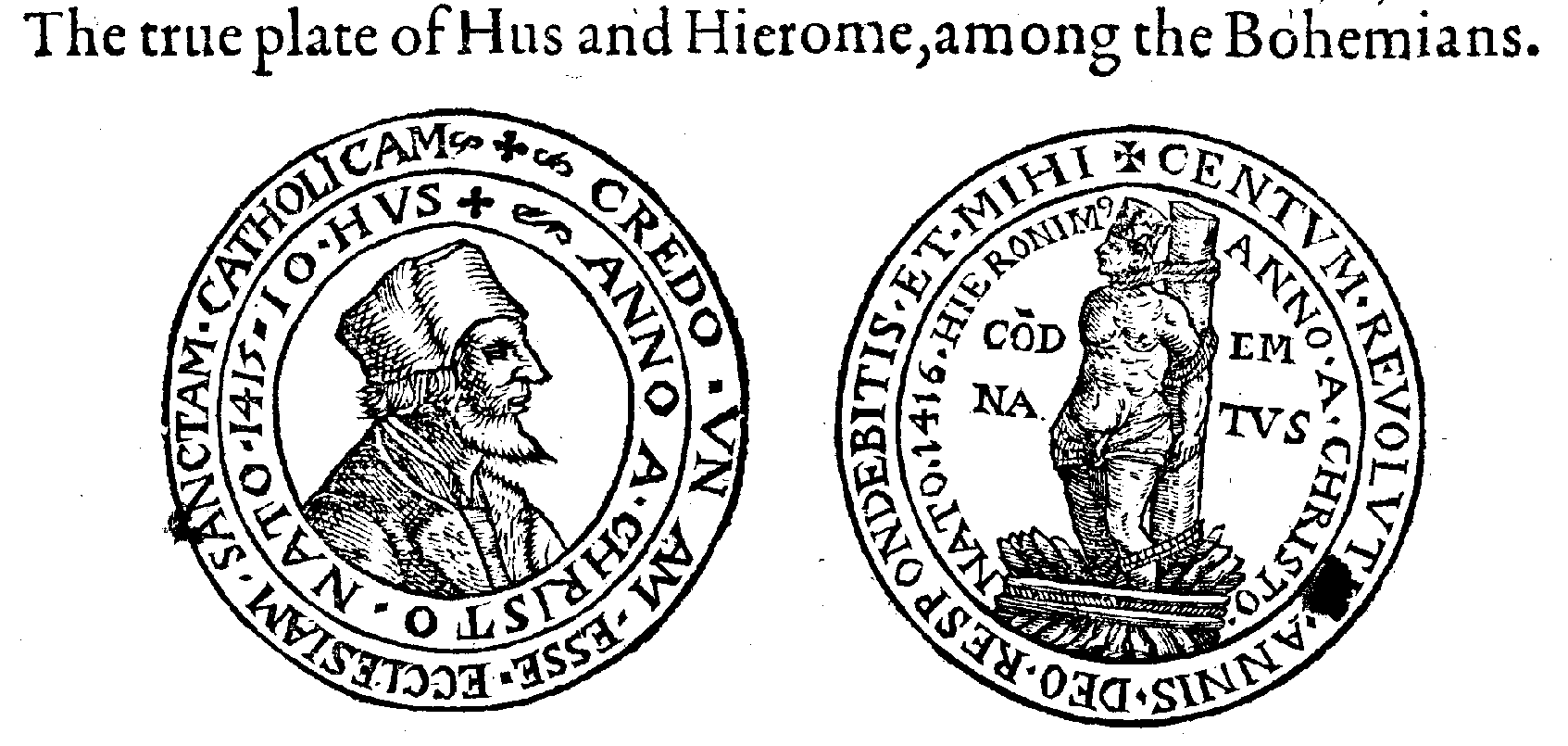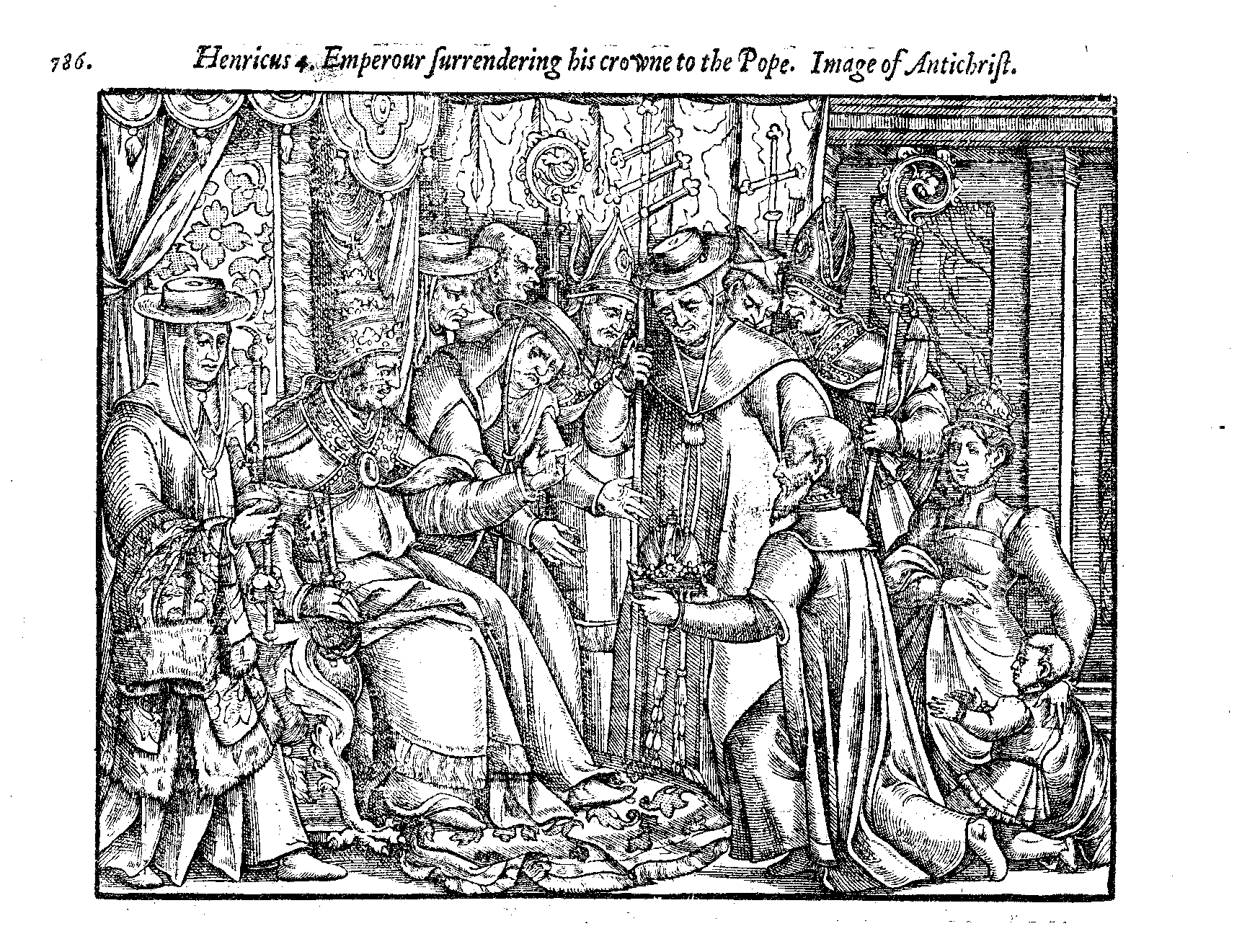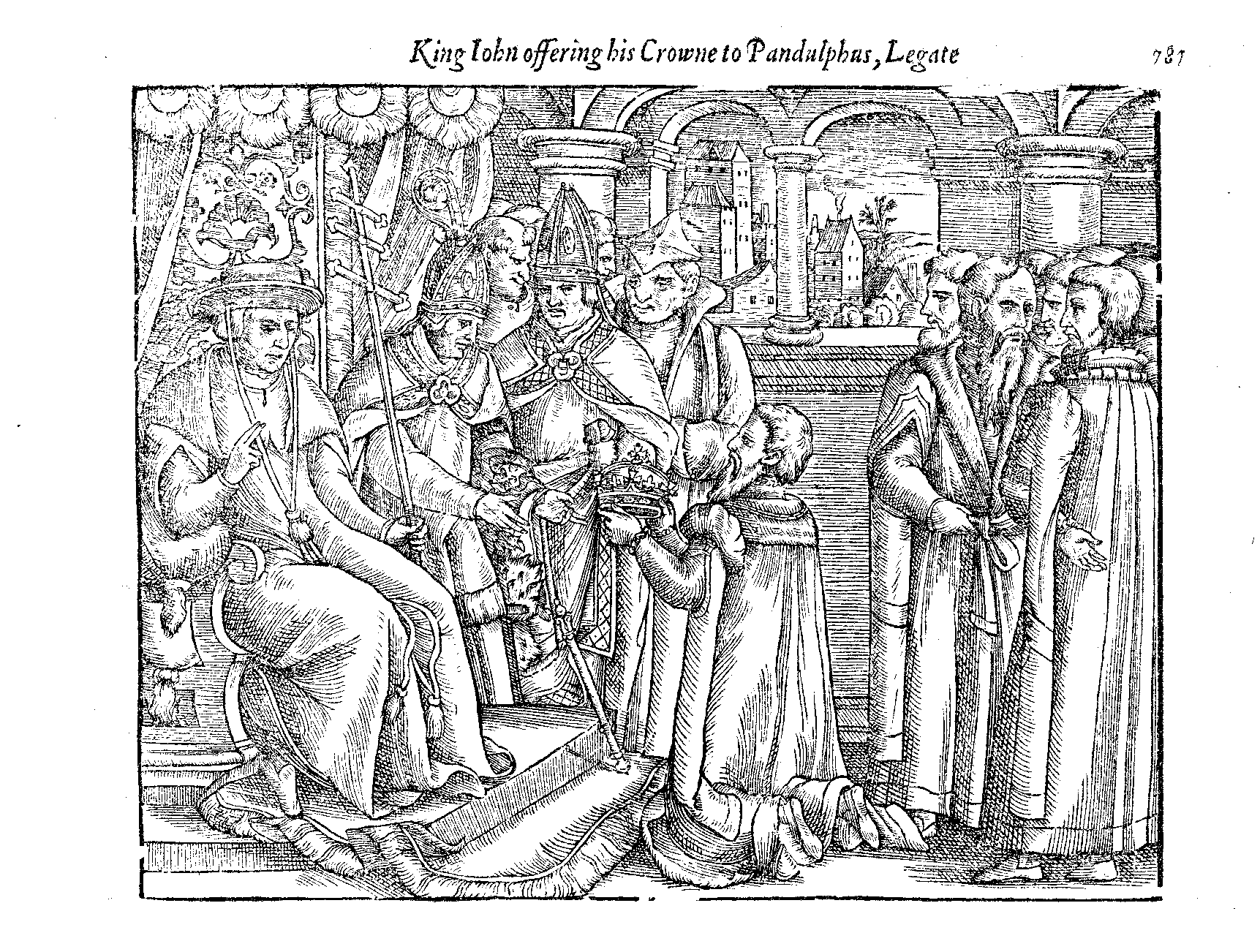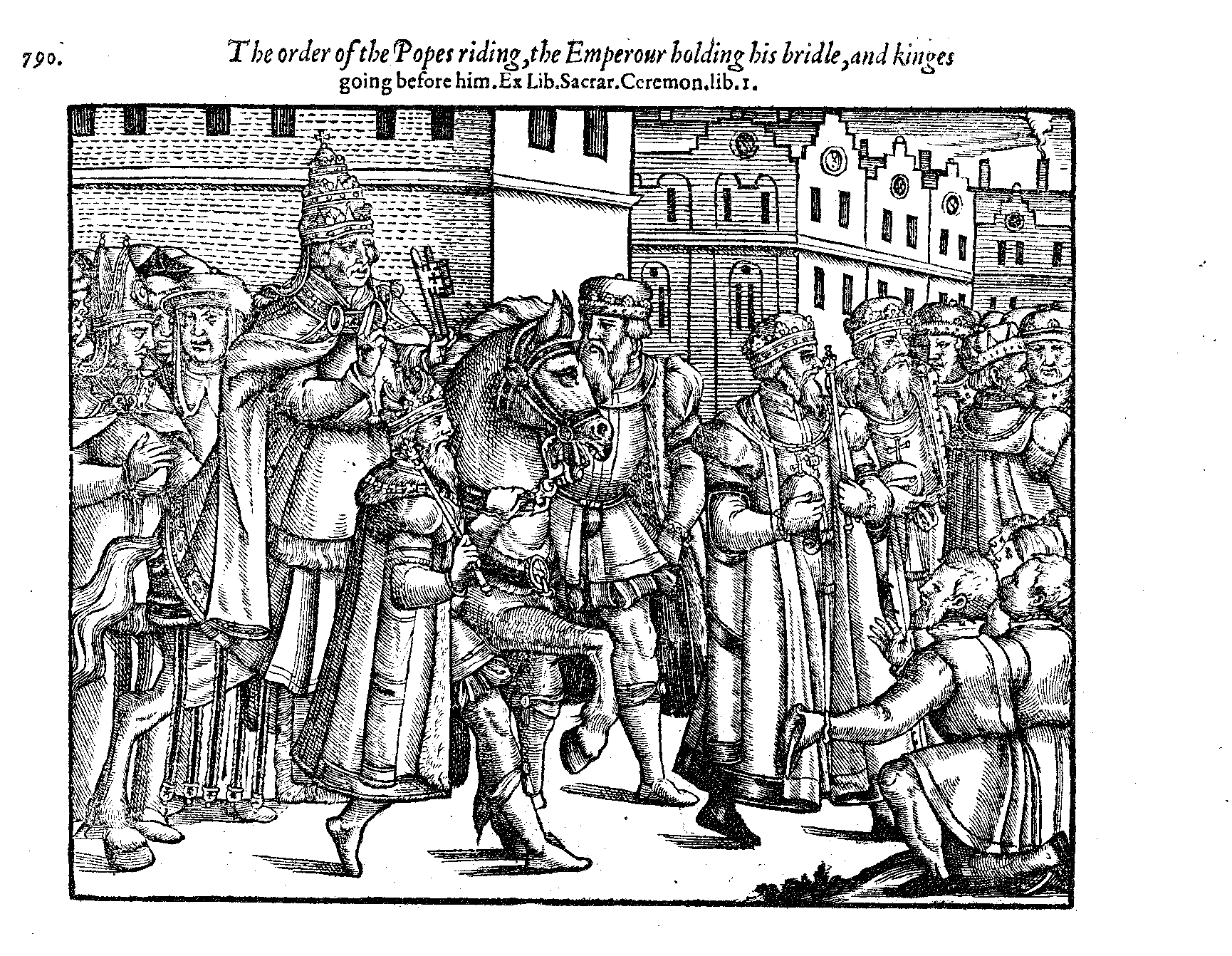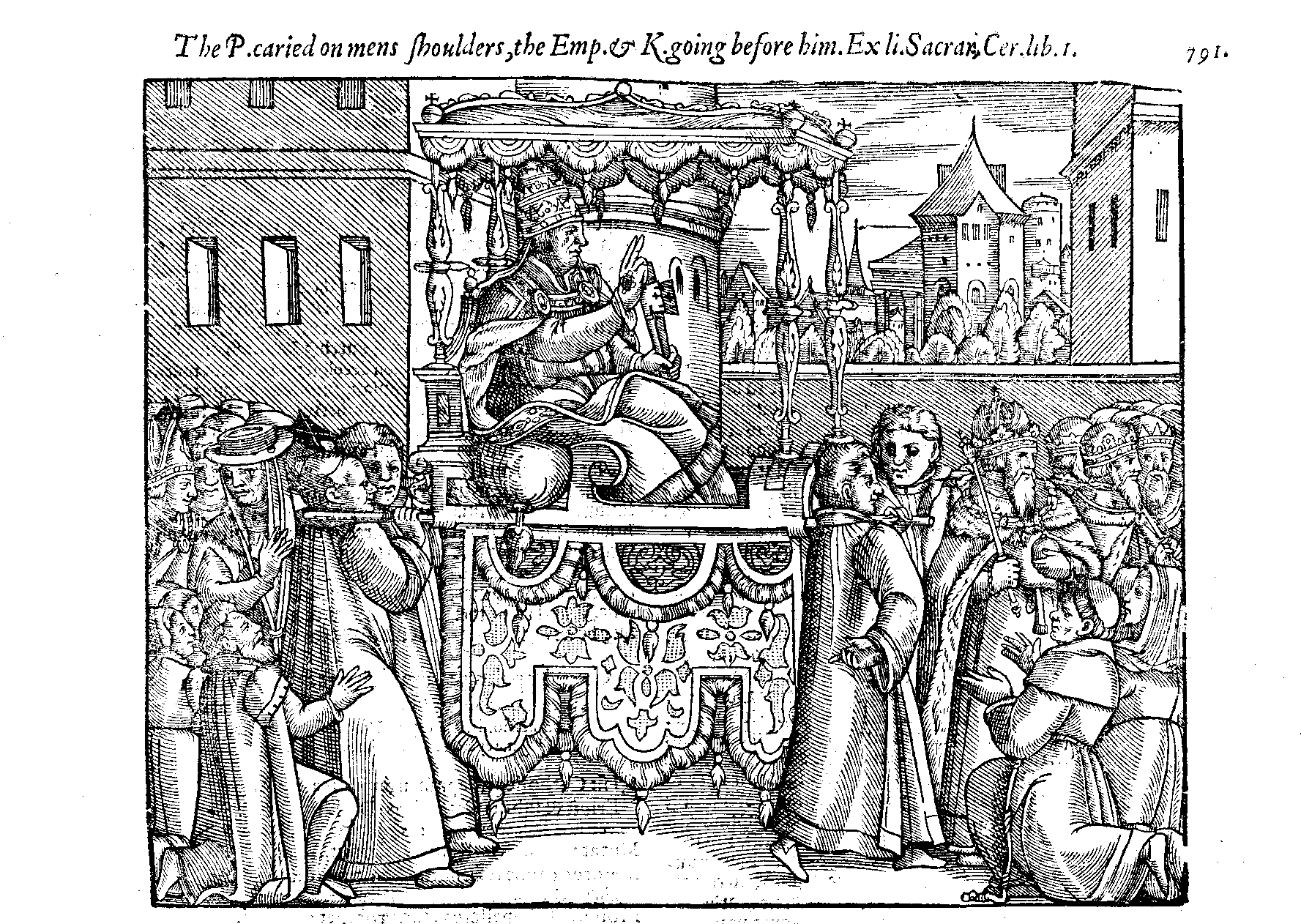Commentary on the TextCommentary on the GlossesCommentary on the WoodcutsLatin/Greek TranslationsCattley Pratt ReferencesThematic DivisionsTextual TranspositionsTextual VariationsGlossary of PeopleGlossary of PlacesEssaysBibliographyAbbreviations
The burning of William Tailour, Priest. (Wylliam Tayler...The displyng of Iohn FlorenceThe burnyng of William White. (Wylliam White Priest. 1563)The description of the penance of Tho. Pye, and Iohn...The burning of Rich, Houeden.The burning of Tho. Rhedonensis. (The story of Thomas...The burning of Rich. Wiche.The burnyng of Iohn GooseThe burnyng of BabramThe Martyrdome of Hierome and his two companions.The true plate of Hus and Hierome, among the Bohemians.The burnyng of Thomas Barnard, and Iames Mordon.The Image of the true Catholicke Church of Christ.Constantinus the Emperour embrasing Christen Bishops.Bishops of Rome advaunced by Emperours, Constantinus,...Emperours Kissing the Popes feete. K. Iohns supplication...Pope Cælestinus 4. crowning the Emperour Henricus...Henricus. 4. Emperour. Waiting 3. dayes vpon Pope Gregory...Henricus 4. Emperour surrendering his crowne to the...King Iohn offering his Corwne to Pandulphus, Legate.K. Henry 2. Kissing the knee of the Popes Legate comming...Fridericus. I. Emperour shent for holding Pope Adrians...The order of the Popes riding, the Emperour holding...The Pope caried on mens shoulders, the Emperour &...A liuely picture describing the weight and substaunce...
Commentary on the Woodcuts for Book 6
The burning of William Tailour, Priest. (Wylliam Tayler an English man. 1563)
In Foxe's first edition the story of William Tayler (or Taylor) opens the 'The thirde part or section of this Ecclesiasticall history'. William Taylor, 'a persistent and, in the end at least, fearless follower of Lollard views', was burned for heresy after a long heretical career. We know about his opinions not only from the record of proceedings against him in Archbishop Chichele's register and reports in Thomas Netter's Doctrinale, but also (unusually) from the survival of one of his sermons. Taylor was a native of Worcestershire and sometime principal of St Edmund's Hall, Oxford, who was cited and arrested for heresy on several occasions, the first being for a sermon he preached at Paul's Cross in 1406. He admitted in 1420, when arrested in Bristol, that he had been excommunicate for about fourteen yerars. His long, persistent careeer of heretical sympathies was finally terminated in March 1423, when he was burned at Smithfield as a relapsed heretic. It was his writings that incriminated him, the authorship of which he neither confessed nor denied to be in his own handwriting when examined. Foxe stated that his writings were so 'indifferent' that he deemed them not worthy of such a severe judgement against the man. In 1563 Taylor was represented by one of the vivid group of woodcuts that proved problematical because of their size. It showed a martyr chained to the stake with raised arms and the words 'Lord help me and forgeve them' in a bandarole. In and after 1570 he was illustrated by one of the new small woodcuts. . CUL copy: the martyr is depicted as wearing a white shroud. Although balding, his hair and beard are coloured in light brown. WREN copy: in this copy Tailor's hair and beard are greying slightly.
1563 Edition, page 399 | 1570 Edition, page 802 | 1576 Edition, page 660 | 1583 Edition, page 683[Back to Top]The displyng of Iohn Florence
As recorded by Foxe, John Florence was a turner of Shelton in the Norwich diocese,who denied the authority of the Pope, and held controversial views on saints' days. After examination he had to do penance in Norwich Cathedral. This case is among the examples that show how Foxe's record supplements the extant evidence of the Norwich Heresy Trials 1428-31 edited by Norman Tanner. Florence's name does not appear in these proceedings, but as Foxe includes information that is not otherwise known (for instance about Hugh Pye) it seems that he had access to records now no longer extant. The name 'Boner' on the scourger holding the flail points to this small cut being prepared with an eye more on Marian prosecutions than the punishment of Wycliffites. This woodcut was later reused . It is possible that the decision to reuse it ensured that its banderole remained blank. (For example, compare 1570, p.782 and p.786 with 1576, p. 636 and p. 640.) CUL copy: Florence is depicted naked, save for a white sheet about his midriff. Note that there are flecks of pinkish red on his back, displaying detail not provided by the original illustration. The empty scroll in the top left of the image is edged with purple. Note that, although black ink is used to add detail to the picture where the paint might have obscured it, the word 'So[m]ner' is not detailed with ink, despite its being somewhat obscured by the blue colour of the man's garments. WREN copy: provides the same detail, although the blank scroll is covered over with blue, in an attempt to erase it. Note that the marginal note accompanying the description of 'the displaying' states that the rod used was white yet there is no effort made to ensure that the rod depicted is indeed white in either the CUL or WREN copy.
1570 Edition, page 803 | 1576 Edition, page 660 | 1583 Edition, page 683[Back to Top]The burnyng of William White. (Wylliam White Priest. 1563)
William White was a Wycliffite priest whose influence has largely to be deduced from the evidence of his followers, chiefly those whose trials in the diocese of Norwich are recorded for 1428-31. He is known to have been active also in Kent, and both he and his 'wife' Joan seem to have been effective proselytisers, and to have left groups of supporters in the Tenterden area of Kent as well as East Anglia. The surviving record of White's trial in provides evidence of the views he taught and for which he was condemned in 1428 and burned at Norwich. At least one of his disciples, Margery Baxter, was present at his burning and reported his final attempt to preach being stopped by a blow on his lips. It appears from Foxe's account that he had access not only to the Norwich heresy trial records, which we still have, but also to evidence that no longer survives, which somewhat fleshes out the account of White and his companion preacher, Hugh Pye. Foxe stated that White's wife had 'suffred much trouble & punishment' that year for sharing her husband's beliefs. Her fate remains unrecorded. The woodcut used to illustrate White in the first edition was a repetition of that used for Sir Roger Acton, with the text in the bandarole changed to 'O Lord receive my soul'. This was one of the misfitting set of blocks that were replaced in 1570, when White was represented by one of the new set of small single-column cuts.
1563 Edition, page 404 | 1570 Edition, page 806 | 1576 Edition, page 663 | 1583 Edition, page 686[Back to Top]The description of the penance of Tho. Pye, and Iohn Mendham.
As one of the few small woodcuts that seem tailor-made for a specific event, this image, with its blank banderole and Bonner's name attached to the official with the flail, seems clearly misplaced. CUL copy: both men are depicted as very pale indeed, wearing nothing more than white linen cloths around their midriffs. They are being beaten by a cleric dressed entirely in black. Touches of orange are added to their knees, perhaps to suggest wounds. Additional wounds are also displayed on their backs. The penitent on the left has further wounds added freehand to his right arm. There is a scroll in the upper right portion of the illustration, though the smoke and wall details continue across its outline. The illustrator of this volume has continued the colour of the wall over the scroll also. WREN: the men are depicted in the same manner, although the wounds added to the figures use a deeper, more blood-like red. The scroll in this is covered over with the background colour.
1570 Edition, page 807 | 1576 Edition, page 664 | 1583 Edition, page 687[Back to Top]The burning of Rich, Houeden.
1570 Edition, page 810 | 1576 Edition, page 667 | 1583 Edition, page 690[Back to Top]The burning of Tho. Rhedonensis. (The story of Thomas Rhedon. 1563)
Foxe's account of the French Carmelite, Thomas of Rennes, who was burned in Rome in 1436, was taken from Crespin. In the first edition the woodcut used to illustrate his story was a repeat of that used for William Sawtry, with the words in the banderole changed to 'Lord help me'. When this block was used again for Sawtry in 1570, it had the original inscription ('Jesu have mercy') replaced at the same time that the woodblock was cut back on either side. Meanwhile from 1570 onwards one of the new single-column woodcuts was used for Thomas of Rennes. CUL copy: this martyr is dressed in white and his beard is coloured grey. His hair is brown but, on top, the thinning hair is grey. There is close attention to detail in his features, including liver spots in his bald patch. WREN: in this copy the martyr's hair and beard are greying also, although there is no additional detail of liver spots on his head.
1563 Edition, page 412 | 1570 Edition, page 812 | 1576 Edition, page 669 | 1583 Edition, page 692[Back to Top]The burning of Rich. Wiche.
Richard Wyche, truly a 'veteran Lollard priest' when he went to the stake in 1440, had a heretical career that started near the beginning of the century and took him from Newcastle to London and the Welsh marches. His intermittent appearances suggest that he was associated with Sir John Oldcastle, and was of some standing, since he sent a letter to John Hus (who also received books from him) in 1410, at the same time as Oldcastle wrote to a Bohemian noble. His respect in the eyes of Londoners was such that steps were taken to prevent people pilgrimaging to his place of execution. Foxe's account of Wiche's death is a short but particularly vivid one, describing how a pile of stones was gathered and a cross erected at the site of his execution, after the martyr's death. This interesting event, taking place some time after the death of the martyr would have been difficult to include, since most illustrations depict the moment immediately surrounding the death of the martyr. But the story may have been enough to warrant him having his own illustration (albeit one of the generic, repeated small woodcuts). CUL copy: Wiche is dressed in white with a greying beard. He is clad on top but is depicted as having heavily greying hair. WREN: the same details are added.
1570 Edition, page 851 | 1576 Edition, page 700 | 1583 Edition, page 725[Back to Top]The burnyng of Iohn Goose
John Goose 'or John Huss' was burned at Tower Hill in 1473. Foxe says little of the charges against him, merely recounting how Goose was given a meal at the house of the sheriff, Robert Belisdon, prior to his death in the afternoon. It is unclear why this particular martyr warranted an illustration, unless on account of his name. 'Thus had England also its John Huss as well as Bohemia'. CUL copy: Goose is dressed in white and has light brown hair and beard. Note that the additional details added to those praying around Goose's pyre are rather clumsily executed, They appear as if they are wearing blusher and lipstick, since the colour is so startling. WREN: the same details and poor quality details appear in this copy also.
1570 Edition, page 870 | 1576 Edition, page 716 | 1583 Edition, page 741[Back to Top]The burnyng of Babram
Brabam was martyred in Norfolk, his story first being recounted by Fabian. It is not clear why this particular martyr warranted an illustration.
1570 Edition, page 887 | 1576 Edition, page 730 | 1583 Edition, page 755[Back to Top]The Martyrdome of Hierome and his two companions.
The burning and hanging of Savonarola, together with two other friars, on 23 May 1498, was represented in a small, evidently custom-made image that recalls that of the Lollards in 1414, likewise condemned for secular and spiritual transgression. While they are clearly distinguished by their dress from those earlier offenders, the illustrator has avoided portraying these religious with the characteristics (tonsure, fat girth etc) commonly assigned to members of religious orders. All three were too be seen as godly reformers. The scene is very different from the great display in the piazza in Florence as portrayed in Italy, showing the burning taking place in the civic centre on an impressive specially constructed platform. Note that this is the second illustration to depict the martyrs as apparently deceased (they all have their eyes closed), rather than at the point of suffering or prior to it. CUL: All three men are in white have brown hair and beards. WREN: the same details appear in this copy.
1570 Edition, page 888 | 1576 Edition, page 731 | 1583 Edition, page 756[Back to Top]The true plate of Hus and Hierome, among the Bohemians.
The way in which Foxe's work honoured the Hussite martyrs pictorially is suggestive of the how he may have collected visual, as well as textual materials while he was abroad. This instance is unusual in that 'the true plate' can be pinned to an exact source. The woodcut is a close copy of a Reformation medal celebrating the Bohemian martyr, Jan Hus, and inscribed with the words 'CREDO UNAM ESSE ECCLESIAM SANCTAM CATHOLICAM', and the prophesy attributed to Hus at the stake; 'CENTUM REVOLUTIS ANNIS DEO RESPONDEBITIS ET MIHI'. This was of course wonderfully exact for linkage with Luther (as Foxe duly noted), and it is tempting to think that the martyrologist might have come by a copy of the medral while he was abroad. However, it was adapted, as well as copied, for inclusion in the Acts and Monuments, by being drafted into doing double duty for both Hus (whose name, inscribed on the medal, is omitted) and Jerome of Prague, who, by implication is the figure chained to the stake. CUL: the outer ring is purple (with pink shading), the inner is yellow (with orange shading). There is a blue upper skyline added to both images. The right-hand image, of Jerome, is damaged with metallic undercoat (?) paint. Hus is depicted in profile, wearing black, with a brown beard and brown fur collar; Jerome is tied to the stake wearing a white loincloth and his white 'crown of paper'. Note that here Jerome is depicted as clean shaven and much younger looking than in the image of him at his burning on p.754.
1570 Edition, page 933 | 1576 Edition, page 769 | 1583 Edition, page 794[Back to Top]The burnyng of Thomas Barnard, and Iames Mordon.
Barnard was a husbandman and Mordon a labourer, burned together at Amersham. Foxe only mentions them briefly. However, James Morden (a book owner) was a member of a family with a significant Lollard record (eight members of whom feature in Bishop Longland's investigations). CUL copy: detail provided in the faces with flushes to the cheeks and features detailed in black ink; otherwise this is rather clumsily executed, with some bleed through from the red paint of the flames as a result. There appears also to be some damage to the right-hand side of the image caused by metallic paint. Note that the man on the left, presumably Barnard, is depicted with a greying beard, with some brown and predominantly grey hair. The man on the left is depicted as looking much younger and fresher-faced, with brown hair and beard. The image in the WREN copy is in particularly bad condition. The metallic base paint occurs on many parts of the image, obscuring detail. In this copy there is less grey in Barnard's beard and hair.
1570 Edition, page 938 | 1576 Edition, page 774 | 1583 Edition, page 798[Back to Top]The Image of the true Catholicke Church of Christ.
Part of the pictorial amplification of the 1570 edition of the Acts and Monuments, with its heightened animus against the pope, was the sequence of twelve woodcuts entitled 'The proud primacy of popes painted out in tables'. This polemical addition, like the huge ten Persecutions woodcut at the beginning of the book with which it was linked, textually and iconographically, was added at the end of volume one as part of a last-minute declaratory response to the 1570 papal bull excommunicating Elizabeth, causing considerable hiatus to the formatting of the book. Like the enormous prefatory 'Table', 'the proud primacy of popes' drew on traditional as well as Reformation iconography. Of these twelve woodcuts one was a repeat. This was the Canossa scene considered above, which was an obvious odd man out in the series, being smaller than the rest. It seems likely that whoever designed the others in this series drew on existing exemplars, and there were plenty of sources, pre- as well as post-Reformation. Here, as in the Ten Persecutions picture, the illustrators drew on a range of precedents, and in both instances it is clear that continental sources were a model. An important text was Cranach's Passional Christi und Antichristi of 1521, with its paired contrasting images of the life of Christ and Antichrist, demonstrating the antithesis between Christ's simplicity and papal pomp. The influence of Cranach's images is clear in the fourth and twelfth of the Foxe series, showing the emperor kissing the pope's feet, and the pope being pope 'carried on men's shoulders' in a canopied litter -- itself an image of neutral content that had acquired contentious meaning. The opening woodcut for this section depicts an emperor watching scenes of savage persecution. It may have been designed to illustrate persecutions of the early Christians. It certainly bears a marked resemblance in style and composition to the woodcut of the ten persecutions of the early church. Perhaps it was even a prototype for that larger woodcut, put to use in this section. Like the huge prefatory woodcut this illustration shows the designer borrowing from Dürer's Martyrdom of the Ten Thousand.in its presentation of the terrible eye-boring, and in the figure of the emperor on the left. These resemblances suggest that work on the two pictorial additions were carried out in tandem. There is a peculiar dislocation between the the seated emperor and the tortures over which he presides, that seems to call for explanation. The figure of the enthroned emperor on the left is incongruous on several counts. He and his courtiers are huddled into a very small space; they also appear out of proportion with the other figures in the woodcut; they are almost twice the size of the torturers. It is also noteworthy that the seated ruler and his courtiers, unlike the other figures in the woodcut, bear marked similarities in style to depictions in other woodcuts in this section of the Emperor Constantine. It is therefore possible that the figure of the emperor and his courtiers were actually part of a larger picture carved on a separate block, which was then joined to the original woodcut to make a more suitable picture for this section. CUL copy: this is the first use in the volume of a heavy, thick royal blue for clothing. There is considerable detail provided in the colouring in of this picture, such as in the wounds inflicted. See, for example, the wounds of the man being savaged by lions in the background. It appears likely that a different painter worked on this section, the Proud Primacy, from the rest of the volume; some of the stock of colours and techniques employed are different. WREN copy: the clothes in this copy are not as detailed as in the CUL copy but this could be due to damage. The blood flecks added to this copy are cruder. The curtains are in green.
1570 Edition, page 946 | 1576 Edition, page 780 | 1583 Edition, page 804[Back to Top]Constantinus the Emperour embrasing Christen Bishops.
CUL copy: the curtains in this copy are in red, with blue fringing. The wall curtain is in green. The Emperor is wearing grey, with green edging. The embraced bishop is in blue with finely detailed shadows depicted on his robe. WREN copy: The curtains here are green with a yellowish orange fringing. The wall curtain is in purple. The embraced figure is wearing black. This image is not as lavish as that in the CUL copy.
1570 Edition, page 947 | 1576 Edition, page 781 | 1583 Edition, page 805[Back to Top]Bishops of Rome advaunced by Emperours, Constantinus, Theodosius. &c.
CUL copy: note the attention to detail in this illustration: tiny, individual brushstrokes are used to suggest the weave of the fabric in the Emperor's clothing. The detail added to the marbling on the right-hand pillar replicates that added to the pillars in other images, such as the 'Vivate Rex' on the verso of the title page. WREN copy: this copy is not as detailed as that in the CUL copy.
1570 Edition, page 948 | 1576 Edition, page 782 | 1583 Edition, page 806[Back to Top]Emperours Kissing the Popes feete. K. Iohns supplication to the Pope.
CUL copy: the cardinals and pope are dressed in bright orange. Note that there is additional detail in gold on the pope's garments and a tiny amount on the vestments also. WREN copy: the figures are wearing orange in this copy also but note that there is no gold in this copy.
1570 Edition, page 949 | 1576 Edition, page 783 | 1583 Edition, page 807[Back to Top]Pope Cælestinus 4. crowning the Emperour Henricus 6. with his feete.
CUL copy: gold detail is added to clothing in this illustration also. Some additional detail is added in black ink also; see, for example, the keys in the pope's left hand. WREN copy: this copy has none of the detail of the detail of the CUL copy.
1570 Edition, page 950 | 1576 Edition, page 784 | 1583 Edition, page 808[Back to Top]Henricus. 4. Emperour. Waiting 3. dayes vpon Pope Gregory 7. Image of Antichrist.
CUL copy: In this image, gold detail is added to the garments of all three central figures, as well as to those of the pope in the window. WREN copy: There is no use of gold in this image, which, on the whole, is very pale.
1570 Edition, page 951 | 1576 Edition, page 785 | 1583 Edition, page 809[Back to Top]Henricus 4. Emperour surrendering his crowne to the Pope. Image of Antichrist.
CUL copy: This illustration manifests many contradictions in its colouring in. In many ways it is more crudely coloured in than those preceding it. For example, the clothing of the cardinals is in red but in block colour, with no attempt to provide detail or shading. However there is attention to detail in other parts of the picture, such as in the faces and headwear. The depiction of shadows is unrealistic - somewhat medieval in its representation. WREN copy: a very pale version, the cardinals' vestments are in a pale orange wash, rather than a block colour.
1570 Edition, page 952 | 1576 Edition, page 786 | 1583 Edition, page 810[Back to Top]King Iohn offering his Corwne to Pandulphus, Legate.
CUL copy: Note all figures in this illustration are provided with additional detail by the painter. Pandulphus receives no extra attention but the figure, in red, on the right of the illustration, has been provided with additional detail. WREN copy: another pale image, with the cardinals in pale orange.
1570 Edition, page 953 | 1576 Edition, page 787 | 1583 Edition, page 811[Back to Top]K. Henry 2. Kissing the knee of the Popes Legate comming into England.
CUL copy: as with other images in this section, additional detail is provided to the image but none (including a lack of shading) is provided to the robes depicted in red. WREN copy: another pale image, with the cardinals in pale orange.
1570 Edition, page 954 | 1576 Edition, page 788 | 1583 Edition, page 812[Back to Top]Fridericus. I. Emperour shent for holding Pope Adrians styrrup on the wrong side.
CUL copy: The pope is dressed in a vivid blue. There is some additional detail provided by the painter but, again, any figures wearing red receive no additional detail to their clothing or any shading. WREN copy: this is another pale image, with an excessive use of a pale orange in this image.
1570 Edition, page 955 | 1576 Edition, page 789 | 1583 Edition, page 813[Back to Top]The order of the Popes riding, the Emperour holding his bridle, and kinges going before him. Ex. Lib. Sacrar. Ceremon. Lib. I.
CUL copy: a significant amount of additional detail is provided by the painter in this illustration, although, again, no additional detail is provided over the top of the colour red when used. A particularly vivid green is also used in this illustration; see, for example, the figure in the bottom right of the illustration, on his bended knee with his cap in his left hand. WREN copy: another pale image, although there is a lot of detailing in black ink.
1570 Edition, page 956 | 1576 Edition, page 790 | 1583 Edition, page 814[Back to Top]The Pope caried on mens shoulders, the Emperour & kings going before him. Ex. Lib. Sacrar. Ceremon.lib.I.
CUL copy: a significant amount of additional detail is provided by the painter in this illustration, although, again, no additional detail is provided over the top of the colour red when used. WREN copy: another pale image, although there is a good attempt made to provide detail to the clothing depicted, particularly the fur collars. There is, however, too much detail provided in black ink.
1570 Edition, page 957 | 1576 Edition, page 791 | 1583 Edition, page 815[Back to Top]A liuely picture describing the weight and substaunce of Gods most blessed word agaynst the doctrines and vanities of mans traditions.
The image of Justice reaching judgement with a pair of scales was an ancient formula that was readily adapted to Reformation issues. The woodcut depicting Justice demonstrating the weight of 'Verbum Dei' over the book of papal Decretals made its first appearance in the Acts and Monuments in 1576, when it was placed as the closing image of the first half of the work. It had first appeared three years earlier on the last page of Foxe's edition of The Whole Works of Tyndale, Frith and Barnes, printed by Day in 1573. The illustration appears to have been inspired by Foxe himself, who described in 1570 an image of a balance, weighing on one side 'books condemned'; and on the other 'books allowed'. The scales of justice were applied to the contrasting worlds of evangelists whose lived by the word alone, untramelled and themselves not weighted down by the opposing popish apparatus of rosaries and pardons and agnus dei and crosses and croziers. Those who stand thus liberated at Justice's right hand occupy a light and spacious world, thanks to the spiritual freedom they have found. They and their church on the distant hill prove their liberation at the hand of Justice, blindfold, impartial, and impervious to devilish antics: 'Gods holy truth...against manifest idolatry', as Foxe himself put it.
1576 Edition, page 795 | 1583 Edition, page 818[Back to Top]








